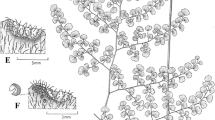Summary
A structural study of pollination in the dimorphic flowers ofCollomia grandiflora, a cleistogamous species, reveals significant differences in stigma behavior during pollination, stylar structure, the timing of generative cell division, and pollen tube growth rate patterns. The cleistogamous flower shows a loss of protandry and the stigma is receptive only after reflexing and closing of its lobes. In contrast, the chasmogamous stigma is receptive when reflexed and closes when pollen has been deposited on the lobes. Pollen tube penetration of the dry stigma papillae and entry into the style is similar in the two morphs. The chasmogamous style is solid and the cleistogamous style partly hollow. The matrix of secretion produced by the transmitting tract cells is mainly carbohydrate with a trace of lipids. It is fibrillar in nature and appears to be partly comprised of wall material from the transmitting tract cells. In the chasmogamous pollen, the generative cell enters the tube before division, which occurs between 30 and 60 min after pollination. This division correlates with an increased growth rate for the pollen tube. In the cleistogamous pollen, contact with the stigma triggers generative cell division inside the hydrated pollen grain before germination. The two resulting sperm cells exit the grain 15–30 min after pollination when the pollen tube is in the stigma lobes. The cleistogamous pollen tube shows only one phase of growth which occurs at a rate similar to that of the slow, first phase of the chasmogamous pollen.
Similar content being viewed by others
Abbreviations
- CH:
-
chasmogamous
- CL:
-
cleistogamous
- DAPI:
-
4′, 6-diamidino-2-phenylindole
References
Brewbaker JL (1967) The distribution and phylogenetic significance of binucleate and trinucleate pollen grains in the angiosperms. Amer J Bot 54: 1069–1083
Buttrose MS, Grant WJR, Lott JNA (1977) Reversible curvature of style branches ofHibiscus trionum L., a pollination mechanism. Aust J Bot 25: 567–570
Capoor SP (1937) The life history ofHoloptelea integrifolia Planch. (Ulmaceae). Beihefte Bot Centralbl 57: 233–249
Coleman AW, Goff LJ (1985) Applications of fluorochromes to pollen biology. I. Mithramycin and 4′, 6-diamidino-2-phenylindole (DAPI) as vital stains and for quantitation of nuclear DNA. Stain Technol 60: 145–154
Cresti M, van Went JL, Pacini E, Willemse MTM (1976) Ultrastructure of transmitting tissue ofLycopersicon peruvianum style: development and histochemistry. Planta 132: 305–312
Darwin C (1897) The different forms of flowers on plants of the same species. Appleton, New York
Ellstrand NC, Lord EM, Eckard KJ (1984) The inflorescence as a metapopulation of flowers: position-dependent differences in function and form in the cleistogamous speciesCollomia grandiflora Dougl. ex Lindl. (Polemoniaceae). Bot Gaz 145: 329–333
Heslop-Harrison J (1983) Self-incompatibility: phenomenology and physiology. Proc R Soc Lond [Biol] 218: 371–395
Heslop-Harrison Y (1977) The pollen-stigma interaction: pollen tube penetration inCrocus. Ann Bot 41: 913–922
Jensen WA, Fisher DA (1969) Cotton embryogenesis: the tissues of the stigma and style and their relation to the pollen tube. Planta 84: 97–121
Johri BM, Shivanna KR (1977) Differential behaviour of 2 and 3-celled pollen. Phytomorphology 27: 98–106
Knox RB (1984) Pollen pistil interactions. Annu Rev Plant Physiol 17: 508–608
Lord EM (1981) Cleistogamy: a tool for the study of floral morphogenesis, function, and evolution. Bot Rev 47: 421–449
—, Eckard KJ (1984) Incompatibility between the dimorphic flowers ofCollomia grandiflora, a cleistogamous species. Science 223: 695–696
— — (1986) Ultrastructure of the dimorphic pollen and stigmas of the cleistogamous species,Collomia grandiflora (Polemoniaceae). Protoplasma 132: 12–22
—, Hill JP (1987) Evidence for heterochrony in the evolution of plant form. In: Raff RA, Raff E (eds) Development as an evolutionary process. Alan Liss, New York, pp 47–70 (MBL lectures in biology series)
Mayers AM, Lord EM (1984) Comparative flower development in the cleistogamous speciesViola odorata. III. A histological study. Bot Gaz 145: 83–91
Mulcahy GB, Mulcahy DL (1983) A comparison of pollen tube growth in bi and trinucleate pollen. In: Mulcahy DL, Ottaviano E (eds) Pollen: biology and implications for plant breeding. Elsevier, New York, pp 29–33
Pearse AGE (1972) Histochemistry, theoretical and applied, vol 2, 3rd edn. Williams and Wilkens, Baltimore
Rosen WG, Gawlik SR (1966) Fine structure of lily pollen tubes following various fixation and staining procedures. Protoplasma 61: 181–191
Sanders LC, Lord EM (1988) Tricellular pollen in the cleistogamous flowers ofCollomia grandiflora; a species with normally bicellular pollen. Amer J Bot (Abstr) 75: 59–60
— — (1989) Directed movement of latex particles in the gynoecia of three species of flowering plants. Science 243: 1606–1608
Uphof JCT (1938) Cleistogamic flowers. Bot Rev 4: 21–49
Author information
Authors and Affiliations
Rights and permissions
About this article
Cite this article
Sanders, L.C., Eckard, K.J. & Lord, E.M. Divergent pollination systems in the cleistogamous species,Collomia grandiflora (Polemoniaceae). Protoplasma 159, 26–34 (1990). https://doi.org/10.1007/BF01326632
Received:
Accepted:
Issue Date:
DOI: https://doi.org/10.1007/BF01326632




